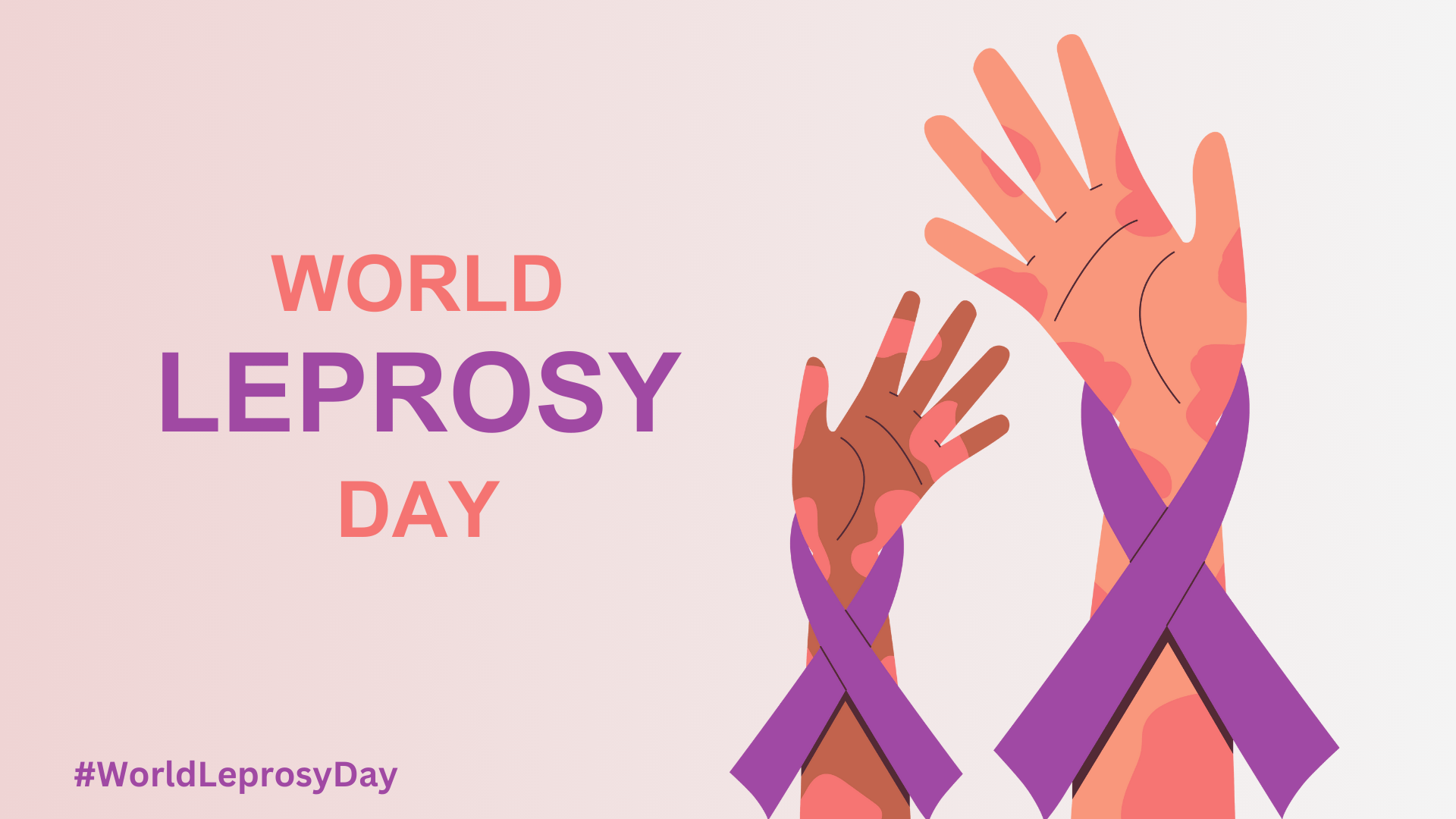Introduction
Every year, World Leprosy Day is observed on the final Sunday of January. In the year 2024, this significant day falls on Sunday, January 28th. Annually, 200,000 individuals receive a leprosy diagnosis, and millions endure the detrimental effects of delayed treatment for this condition. This annual event serves as a global reminder to raise awareness about leprosy, fostering understanding and support for those affected by this age-old disease.
Join us in commemorating World Leprosy Day on the 28th of January, as we unite in the ongoing efforts to eliminate stigma and enhance compassion for individuals impacted by leprosy.
What Is Leprosy?
Leprosy, also known as Hansen’s disease, is a persistent bacterial infection caused by Mycobacterium leprae. It primarily affects the nerves in the extremities, the skin, the lining of the nose, and the upper respiratory tract. This condition can lead to skin ulcers, nerve damage, and muscle weakness, potentially resulting in severe disfigurement and significant disability if left untreated.
With a history dating back to around 600 B.C., Hansen’s disease is one of the oldest recorded diseases. While it is prevalent in many countries, particularly those with tropical or subtropical climates, it is not very common in the United States.
According to the Centers for Disease Control and Prevention (CDC), only 150 to 250 new cases are diagnosed in the United States each year.
History Of World Leprosy Day
World Leprosy Day was established in 1954 by the compassionate French humanitarian Raoul Follereau. His vision was to dedicate a day to raising global awareness about leprosy, aiming to eradicate the discrimination faced by those living with the disease.
Choosing January 30th, the anniversary of Gandhi’s passing, Raoul Follereau inaugurated the first World Leprosy Day in 1953. This initial observance sought to honor Gandhi’s humanitarian legacy while drawing attention to the ongoing global battle against leprosy.
World Leprosy Day has since evolved into a widespread global initiative, garnering support from organizations such as the World Health Organization (WHO) and the International Federation of Anti-Leprosy Associations (ILEP). It serves as a crucial platform to dispel myths surrounding leprosy, advocate for early detection and treatment, and champion the social inclusion of individuals affected by this disease.
Theme Of World Leprosy Day 2024
The focal point for World Leprosy Day in 2024 revolves around the theme “Beat Leprosy.” This overarching theme encompasses the dual goals of dispelling the stigma attached to leprosy and championing the dignity of individuals impacted by the disease. It underscores the imperative to not only address the medical aspects but also tackle the societal challenges in eradicating leprosy.
“Beat Leprosy” advocates for a global paradigm shift, envisioning a world where leprosy ceases to be a source of stigma, transforming instead into an opportunity to uphold dignity and eradicate discrimination.
Mode Of Transmission For Hansen’s Disease
- Leprosy spreads through respiratory droplets released from the nose and mouth during close and repeated contact with untreated cases.
- It’s important to note that the disease doesn’t easily transfer through casual interactions like handshakes or conversations.
- Transmission typically requires prolonged, intimate exposure over several months. Once treatment begins, the patient ceases to be contagious.
- Leprosy exhibits considerable variability, affecting individuals differently based on their immune responses.
- Those with high immunity may carry a low bacilli count and experience minimal symptoms, while individuals with lower immunity may harbor more bacilli, leading to severe symptoms.
Symptoms Of Leprosy
- Symptoms predominantly manifest in the skin, nerves, and mucous membranes, presenting as discolored patches, nodules, thickened or dry skin, and painless ulcers.
- Mucous membrane symptoms include a congested nose and nosebleeds. Loss of sensation may lead to unnoticed injuries.
- Advanced leprosy, if untreated, can result in paralysis, hand and foot deformities, chronic ulcers, blindness, and facial disfigurement.
- Nerve damage induces numbness, muscle weakness, and enlarged nerves.
Fortunately, leprosy is curable, and early treatment can prevent long-term disabilities. Understanding these aspects is vital for accurate information dissemination and dispelling myths surrounding leprosy.
Myth Busting On Leprosy
Myth: Leprosy only affects the skin.
Fact: Leprosy can impact nerves, mucosal surfaces, and other organs, leading to a range of symptoms beyond skin manifestations.
Myth: All individuals with leprosy are highly infectious.
Fact: The level of infectiousness varies, and most people with leprosy on proper treatment cease to transmit the disease.
Myth: Leprosy is highly contagious and easily spreads from person to person.
Fact: A persistent myth about leprosy is its high contagion, but in reality, it is challenging to contract and primarily spreads through prolonged contact. Remarkably, around 95% of people have a natural immunity to the disease.
Myth: Leprosy is due to poor hygiene
Fact: Contrary to a common myth, leprosy is not linked to poor hygiene; it is caused by the Mycobacterium leprae bacteria transmitted through respiratory droplets. Personal hygiene does not influence the transmission of the disease.
How To Raise Awareness On World Leprosy Day?
In observance of World Leprosy Day, individuals and organizations have the opportunity to foster awareness through diverse initiatives. Hosting webinars, seminars, and workshops serves as an effective means to educate the public about the disease, its symptoms, and modes of transmission.
Leveraging social media platforms enables the sharing of pertinent information about World Leprosy Day, urging friends and followers to actively engage in discussions and endorse the cause. Additionally, contributing to organizations and charities dedicated to leprosy awareness, treatment, and research through donations is a tangible way to make a positive impact.
Through these concerted efforts, we can collectively strive to eliminate the stigma surrounding leprosy and provide meaningful support to those affected by the disease. A comprehensive digital toolkit is now available for those interested in participating in the World Leprosy Day 2024 campaign.
Leprosy Rate In India
As of 2024, India has successfully achieved the elimination of leprosy as a public health problem, meeting the WHO criteria of less than 1 case per 10,000 population. The country has launched the National Strategic Plan (NSP) & Roadmap for Leprosy (2023-27) to achieve zero transmission of leprosy by 2027, surpassing the Sustainable Development Goal (SDG) 3.3 by three years.
The NSP and Roadmap outline comprehensive strategies, year-wise targets, public health approaches, and technical guidance to promote awareness, early case detection, and prevent disease transmission. Despite a significant reduction in the number of new cases, with 75,394 detected, India still contributes 57% of the global new leprosy cases identified in 2019-20.
While notable progress has been made, it is crucial to recognize that certain districts within States/UTs continue to face leprosy endemicity. Sustaining achievements requires ongoing efforts to address these remaining challenges and move towards the overarching goal of zero leprosy.
Conclusion
World Leprosy Day serves as an annual occasion to bring attention to leprosy underscoring the crucial importance of early detection and treatment. This day mobilizes collective endeavors towards eradicating the disease and extending steadfast support to those affected. By promoting awareness, we contribute to dismantling the stigma surrounding leprosy. Let’s come together in our commitment to eliminate this ancient ailment, extending compassion and understanding to those facing its challenges.
Join the cause, share knowledge, and make a positive impact on the lives of individuals affected by leprosy. Wearing the purple ribbon, the symbol for leprosy awareness signifies our commitment to raising awareness and fostering empathy. Join the cause, share knowledge, and contribute to building a stigma-free world.
Written By
Aswini PriyaMedical Content Writer
Reviewed By
Dr. AnchalMedico Expert
Last Updated
28 Jan 2024 | 02:50 PM (IST)










